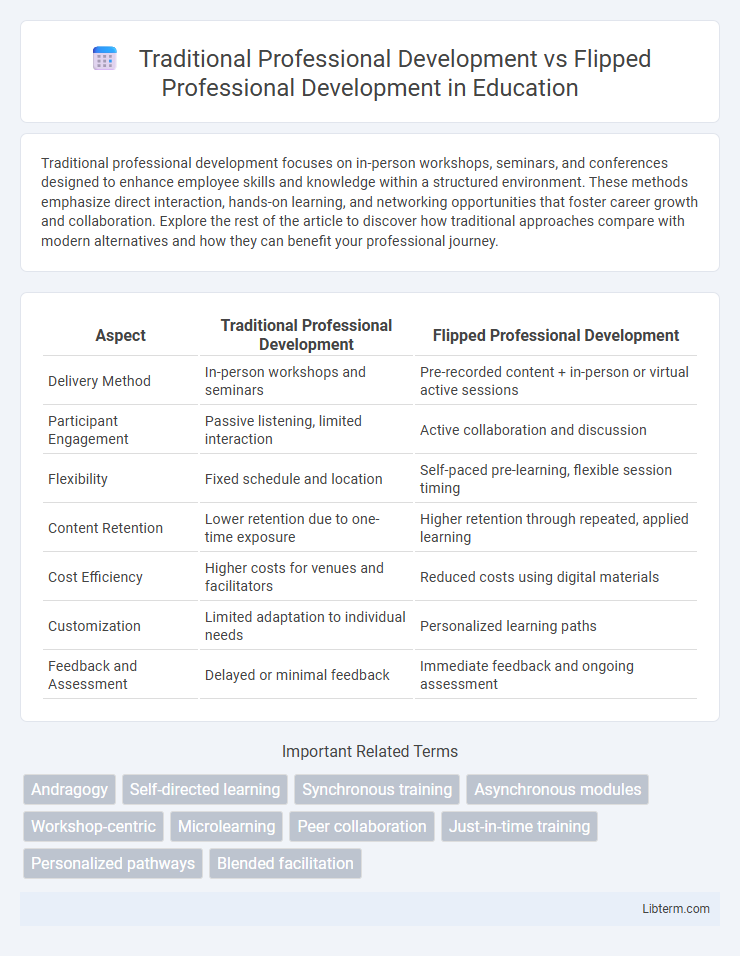Traditional professional development focuses on in-person workshops, seminars, and conferences designed to enhance employee skills and knowledge within a structured environment. These methods emphasize direct interaction, hands-on learning, and networking opportunities that foster career growth and collaboration. Explore the rest of the article to discover how traditional approaches compare with modern alternatives and how they can benefit your professional journey.
Table of Comparison
| Aspect | Traditional Professional Development | Flipped Professional Development |
|---|---|---|
| Delivery Method | In-person workshops and seminars | Pre-recorded content + in-person or virtual active sessions |
| Participant Engagement | Passive listening, limited interaction | Active collaboration and discussion |
| Flexibility | Fixed schedule and location | Self-paced pre-learning, flexible session timing |
| Content Retention | Lower retention due to one-time exposure | Higher retention through repeated, applied learning |
| Cost Efficiency | Higher costs for venues and facilitators | Reduced costs using digital materials |
| Customization | Limited adaptation to individual needs | Personalized learning paths |
| Feedback and Assessment | Delayed or minimal feedback | Immediate feedback and ongoing assessment |
Introduction to Professional Development Models
Traditional Professional Development models emphasize instructor-led workshops with fixed schedules and passive learning, often leading to limited engagement and retention. Flipped Professional Development reverses this approach by delivering content asynchronously, allowing educators to explore materials independently before collaborative, hands-on sessions, promoting deeper understanding and practical application. Research indicates flipped models increase teacher participation and efficacy by fostering active learning and personalized pacing.
Defining Traditional Professional Development
Traditional professional development typically involves instructor-led workshops or seminars where educators passively receive information at scheduled times. This model emphasizes direct teaching with limited interactivity, often conducted in-person and spanning a fixed duration. Its structure prioritizes content delivery over personalized learning, often resulting in lower engagement and retention compared to more learner-centered approaches.
Explaining Flipped Professional Development
Flipped Professional Development transforms traditional training by delivering instructional content online for educators to review at their convenience, allowing in-person sessions to focus on collaborative activities and practical application. This model enhances teacher engagement and retention by promoting active learning, peer interaction, and immediate feedback during workshops. By shifting the passive learning phase outside the classroom, Flipped Professional Development supports continuous improvement and more effective integration of new strategies into teaching practice.
Key Differences Between Traditional and Flipped Approaches
Traditional professional development typically involves passive learning through lectures and workshops, where educators receive information in a fixed schedule without much interaction. Flipped professional development, on the other hand, emphasizes active learning by allowing educators to access instructional materials, such as videos and readings, prior to collaborative sessions that focus on applying knowledge and problem-solving. Key differences include the shift from instructor-led delivery to learner-centered engagement, flexibility in pacing, and increased opportunities for practical application and peer collaboration.
Advantages of Traditional Professional Development
Traditional professional development offers structured, in-person sessions that facilitate immediate interaction and real-time feedback among educators and trainers. This format ensures a consistent learning environment where participants can engage in collaborative discussions and hands-on activities, reinforcing practical skills. Moreover, traditional professional development fosters a sense of community and accountability, often leading to higher participation and retention rates.
Benefits of Flipped Professional Development
Flipped Professional Development enhances educator engagement by allowing teachers to access training materials asynchronously, accommodating diverse schedules and learning paces. This model promotes deeper understanding through active, collaborative in-person sessions that focus on applying concepts rather than passive content delivery. Research indicates flipped PD improves retention and implementation of instructional strategies, leading to more effective classroom outcomes compared to traditional, lecture-based approaches.
Challenges and Limitations of Each Model
Traditional professional development often faces challenges such as limited engagement, passive learning environments, and scheduling conflicts that reduce overall effectiveness for educators. Flipped professional development addresses some of these issues by allowing flexible, self-paced learning but can struggle with participant accountability and requires reliable technology access. Both models encounter limitations in adapting content to diverse teacher needs and balancing time constraints within busy professional schedules.
Impact on Learner Engagement and Outcomes
Traditional professional development often relies on passive learning through lectures, which can limit learner engagement and reduce retention of information. Flipped professional development shifts content delivery to pre-session activities, allowing in-person time to focus on interactive, hands-on practice that enhances engagement and promotes deeper understanding. Research indicates that flipped models lead to improved learner outcomes by fostering active participation and applying knowledge in real-world contexts.
Best Practices for Implementing Flipped Professional Development
Flipped Professional Development (PD) enhances educator engagement by shifting content delivery to self-paced videos and interactive online modules, allowing face-to-face sessions to focus on collaboration and practical application. Best practices for implementing flipped PD include providing high-quality, concise video content, creating opportunities for reflective discussion during in-person meetings, and incorporating ongoing feedback mechanisms to tailor the learning experience. Research shows that these strategies improve teacher retention of new skills and promote active, learner-centered professional growth compared to traditional PD models.
Choosing the Right Professional Development Approach
Traditional professional development often involves passive learning through lectures and workshops, limiting engagement and immediate application of skills. Flipped professional development shifts content delivery outside of sessions, allowing educators to actively collaborate and practice during in-person meetings, enhancing retention and practical implementation. Choosing the right approach depends on factors such as staff availability, learning preferences, and the need for hands-on practice to maximize effectiveness and educator growth.
Traditional Professional Development Infographic

 libterm.com
libterm.com